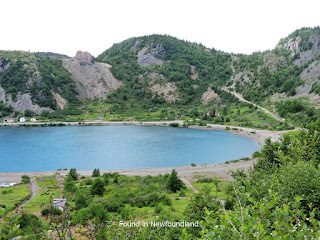Burlington,
Smith’s Harbour, and Middle Arm
I was planning to
continue along Route 414 and write about each community in order along the road, but since The Gathering is happening this week (August 25-27), I’m
going to jump ahead and share what we found when we visited that area.
Several people we talked with on our travels recommended we
visit Burlington, so as we headed back south from Baie Verte, we took a side trip to the home of The Gathering, Shaun Majumder and Rex
Goudie. The town was originally called Northwest Arm, but because it was being confused with another town of the same name, in 1915 the residents chose to change the name to Burlington. It's not clear if the name is modified from Bridlington in England or is taken from Burlington, Ontario (More Than Just a Name, Byron A. Brooks, www.travellingnl.com).
Burlington is a small community, fairly spread out with houses nestled into tall trees. There’s a picturesque boat launch along a road that leads to a pretty little lookout point with what seems to be a small picnic area with seats and a stage overlooking the ocean. I believe that some of the activities for The Gathering take place in this area, while the campground is actually a little outside the town itself. You can read more about The Gathering and see pictures from past events on the website linked above.
Burlington is a small community, fairly spread out with houses nestled into tall trees. There’s a picturesque boat launch along a road that leads to a pretty little lookout point with what seems to be a small picnic area with seats and a stage overlooking the ocean. I believe that some of the activities for The Gathering take place in this area, while the campground is actually a little outside the town itself. You can read more about The Gathering and see pictures from past events on the website linked above.
 |
| Beautiful place |
Across the harbour from the boat launch, you can see the
wharf of Smith’s Harbour, another quiet, linear town. This town was originally named John Smith's Harbour, after what may have been one of the earliest settlers (More Than Just a Name, Byron A. Brooks, www.travellingnl.com). The wharf at the end of town overlooks a small island on one side and a sheltered harbour on the other.
 |
| Couldn't you just stay and soak in this view? |
What we found most interesting about this place was the
garbage cans, which were painted to look like cans of various Newfoundland
products and scattered all throughout the town.
A recent CBC article tells the story of how artist Gail Foster was inspired to spearhead this
project. The article says there are 12
in the town - it’s worth driving around just to see how many you can find. (Looks like we only found 10.)
The third town down Route 413 is Middle Arm. I didn't find any explanations for the name, but I imagined it may have come from the sandbar arm into the middle of the bay which featured a picnic area that would make a lovely
place to stop, have a bite, and enjoy the scenery. At the entrance to the town was a small house atop a set of stone steps that caught my eye. It seems the residents were in the process of painting
a line of colorful fishing sheds along the water’s edge while we were there. The picture below shows three, but there were
many more still being painted in bright hues. They should make for some lovely pictures when
they’re done.
As we approached Middle Arm, on the outskirts of Burlington,
we came across a line of salt fish mounted to dry, overlooking the water. This is an iconic sight in Newfoundland,
although sadly not as easy to find as it used to be.
 |
| Salt fish drying |
If you’re headed to The Gathering, you are in for a great
time in a beautiful spot. Be sure to
save some time to explore the Baie Verte Peninsula – you won’t be sorry. And if you’re not going this week, then add
it to your bucket list – it’s a great place to visit.
Next post: Back to
route 414 and Brent’s Cove


















































